The five Main areas of a wellness program
1. Medical evaluation
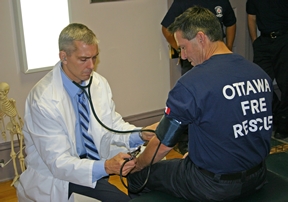 This annual exam has 100% confidentiality between you and your doctor. The exam is from a doctor and medical team that are specifically familiar with diseases associated with fire fighters and their work related injuries. Not all medical professionals have the same background in order to see patterns specific to fire fighter’s health issues. Being a Fire Fighter Physician requires hours of extra reading and related courses.
This annual exam has 100% confidentiality between you and your doctor. The exam is from a doctor and medical team that are specifically familiar with diseases associated with fire fighters and their work related injuries. Not all medical professionals have the same background in order to see patterns specific to fire fighter’s health issues. Being a Fire Fighter Physician requires hours of extra reading and related courses.
If you think about it, this medical exam isn’t about yourself; it is a health check for others. It will help keep your family in a better state of mind knowing that you are less likely to be hurt or injured, or develop a life threatening disease. A Doctor who is familiar with injuries or diseases related to fire fighting might catch a problem earlier. It is also better to get this exam for others at work as patterns can be seen among coworkers. For example, an infection that is caught on the job and spread to co-workers on the same calls or station. The doctor and a well-trained team are also there to teach you about some of the hidden risks you may not be aware of and provide information related to combat those health hazards.
Please see side bar for the IAFF’s Medical Exam to give to your medical provider (from the IAFF Wellness and Fitness Manual).
2. Fitness Evaluation
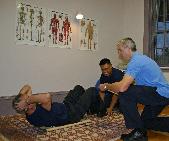 This evaluation is not to compare you to others, it is a tool to educate you on some potential challenges you may have. If in a later fitness evaluation there are some changes in your results, this comparison may help pinpoint the cause. The program is not just about providing you with a weight room but it gives you one on one instruction. This is done throughout the year with qualified Peer Fitness Trainers (PFT) while you are on duty. PFT’S are trained through the IAFF’s program and kept up to date with mandatory training to ensure the quality of service given to fire fighters by fire fighters.
This evaluation is not to compare you to others, it is a tool to educate you on some potential challenges you may have. If in a later fitness evaluation there are some changes in your results, this comparison may help pinpoint the cause. The program is not just about providing you with a weight room but it gives you one on one instruction. This is done throughout the year with qualified Peer Fitness Trainers (PFT) while you are on duty. PFT’S are trained through the IAFF’s program and kept up to date with mandatory training to ensure the quality of service given to fire fighters by fire fighters.
Fire fighting is a total body workout and each fire fighter has strengths and weaknesses. This testing is about getting you to re evaluate your fitness level and to learn some tips to maximize it.
Fire fighting has proven to be at or near maximum heart function. This is why heart failure is the number one cause of fire fighter death. If you pound nails all day your strength is great but you probably need to work on getting your heart pumping. This is not news to you but the tests show real results that are measurable and improvement can be seen quickly and easily with a few tips and a little work. If you want to learn why this is necessary see my anatomy section on the heart.
The tests for evaluation are 1) aerobic capacity which tests your ability to stress the heart and use the oxygen available coming into the system. Basically you get on the treadmill or stair machine while monitored (to ensure your heart rate doesn’t go to high). Your level on the machine increases until YOU decide you have reached your max or your heart monitor will say you have reached your maximum limit. 2) Muscular strength uses devices to measure hand, leg and arm strength. 3) Muscular Endurance which is different to strength in that it looks at the number of times you can do something. It uses push-ups and the static plank as the standard test. And finally 4) Flexibility is sometimes associated with decreased risk of injury to the low back. Back injury is one of the leading causes of disability so the sit and reach test is used.
3. Injury/Medical/Fitness Rehabilitation
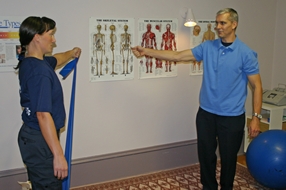 Since our job related injury rate is higher than that of the private industry, fire fighters need a rehab team that is made up of different types of therapists working along side physicians. The range of motion of joints should be evaluated to ensure body parts are being used correctly. The body will mask injuries to muscles and recruit other muscles to do a job. For example in shoulder injuries people begin lifting their arm by leaning their body away from what it is reaching for, instead of letting the shoulder do all the work. That is why evaluation by professionals are necessary to catch injuries that seem to be healed but are really just being masked. If proper rehab is done (using physical therapists, massage therapists, chiropractors etc.) it will assist damaged joints that would have never returned to normal otherwise.
Since our job related injury rate is higher than that of the private industry, fire fighters need a rehab team that is made up of different types of therapists working along side physicians. The range of motion of joints should be evaluated to ensure body parts are being used correctly. The body will mask injuries to muscles and recruit other muscles to do a job. For example in shoulder injuries people begin lifting their arm by leaning their body away from what it is reaching for, instead of letting the shoulder do all the work. That is why evaluation by professionals are necessary to catch injuries that seem to be healed but are really just being masked. If proper rehab is done (using physical therapists, massage therapists, chiropractors etc.) it will assist damaged joints that would have never returned to normal otherwise.
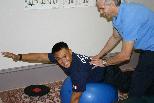 A good program should include education on prevention by bringing qualified individuals to fire fighters at work. Wellness programs must teach safe working conditions. For example, courses on ergonomics and back injury prevention have shown to decrease risk of injuries to firefighters. This should not be done with some packaged handout to be read and forgotten. Rather, it should be taught by professionals with active participation to ensure proper technique.
A good program should include education on prevention by bringing qualified individuals to fire fighters at work. Wellness programs must teach safe working conditions. For example, courses on ergonomics and back injury prevention have shown to decrease risk of injuries to firefighters. This should not be done with some packaged handout to be read and forgotten. Rather, it should be taught by professionals with active participation to ensure proper technique.
4. Behavioural health
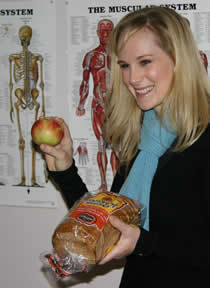 This is a subject that covers a wide range of courses from tobacco and alcohol addiction to weight management and nutrition. These are directly and indirectly related to our body’s ability to handle heat stress, decrease stress to the heart and recover strength for our next call. These topics are very important and a little knowledge by related experts will help firefighters recover quicker.
This is a subject that covers a wide range of courses from tobacco and alcohol addiction to weight management and nutrition. These are directly and indirectly related to our body’s ability to handle heat stress, decrease stress to the heart and recover strength for our next call. These topics are very important and a little knowledge by related experts will help firefighters recover quicker.
Our society is obsessed about weight and weight loss and a wellness program, in my opinion it shouldn’t be the focus. It should be centered on letting the individual know that a healthy weight is desired to limit stress on joints, help the body’s ability to function and to educate them instead of belittling them. A fire department is like a football team that benefits from all shapes and sizes to be successful. While it is important to remember that undertraining can lead to problems, overtraining can also lead to problems as it burns out joints and lowers the body’s ability to deal with stress. Overtraining needs more attention as it is basically causing repetitive stress injuries (RSI) similar to what factory workers get who perform the same task over and over.
A tough subject to talk about is Critical Incident Stress. It is one of the biggest things on this job that is down played for some reason. This is the most underestimated part of a fire fighter’s education and needs more attention then it is given. Trauma from seeing horrible deaths, accidents and other incidents are often hidden. There are no rules on how or when this trauma will surface if ever. I am privileged to have had many members share these stories with me. Stories of job related stress that creeps up from our subconscious, overflowing into our daily lives and affecting the ones we care about most. Speaking from my own experience, I had a seemingly routine medical call involving a child similar in age to my own. It brought back other medical calls involving children from the past. As it turns out, when we got back to the station, my upset telephone conversation with my wife was heard over the station’s PA system. This resulted in a mini group therapy session with grizzled fire fighters. I owe them for overcoming the expected tough guy attitude and giving great advice to get me to the next call and to seek help. One of the best ways I have handled the stress was with a personal development course, called Pathways, that is run out of Chicago. The course has decreased the stress level in both my work and personal life, giving me strategies to handle it better when overloaded (incredible fire fighters and family have forgiven me when I have strayed off the path!). Take this course or something like it and talk to the help lines that are offered through work before you need them. Make sure it is the right fit for you and you are comfortable with the people involved, as some of the things I looked into did nothing for me. You may think you are different and can handle Critical Incident Stress, but why not be prepared just in case.
5. Data Collection
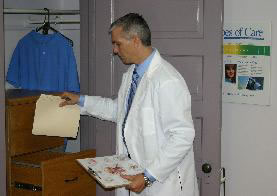 This seemingly dry subject is really important as data is collected in a confidential way to ensure the information is analyzed. It is looking for risk factors in fire personnel populations as a whole or in small geographic areas. This helps create new or more effective ways to decrease injuries and improve the wellness program. Data collection in your private file is the only thing that will guarantee you have proof of a long-term disability. This will decrease the risk of a fight for coverage in the future. A paper trail is needed regardless of the physical proof of you standing in front of them injured or worse.
This seemingly dry subject is really important as data is collected in a confidential way to ensure the information is analyzed. It is looking for risk factors in fire personnel populations as a whole or in small geographic areas. This helps create new or more effective ways to decrease injuries and improve the wellness program. Data collection in your private file is the only thing that will guarantee you have proof of a long-term disability. This will decrease the risk of a fight for coverage in the future. A paper trail is needed regardless of the physical proof of you standing in front of them injured or worse.
